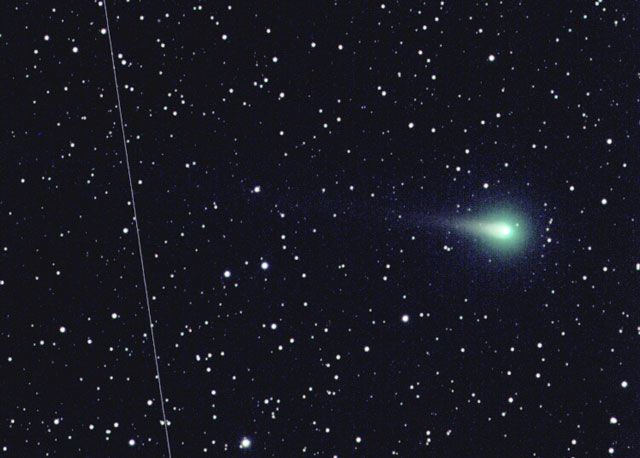Credit & Copyright: Mike Holloway
Explanation:
A newly discovered comet may outshine most stars in the sky by May.
Designated Comet C/2002 T7 (LINEAR), the comet was discovered in 2002 October by
project LINEAR.
Many reports already place the comet as brighter than
magnitude 7, meaning that it can now be seen with binoculars.
Reports also indicate the comet already has a visible
tail nearly the length of a
full Moon.
Since predicting the
future brightness of comets is a very
tricky business, there remains the possibility that
T7 might never become visible to the unaided eye.
Alternatively, another comet,
C/2002 Q4 (NEAT), may also
reach naked eye visibility at nearly the same time,
making 2004 April and May two of the busiest
bright-comet months in centuries.
Comet T7 can be seen on the above right on January 20,
while an airplane trail is visible on the left.
1999 2000 2001 2002 2003 2004 2005 2006 2007 2008 2009 2010 2011 2012 2013 2014 2015 2016 2017 2018 2019 2020 2021 2022 2023 2024 2025 |
Yanvar' Fevral' Mart Aprel' Mai Iyun' Iyul' Avgust Sentyabr' Oktyabr' Noyabr' Dekabr' |
NASA Web Site Statements, Warnings, and Disclaimers
NASA Official: Jay Norris. Specific rights apply.
A service of: LHEA at NASA / GSFC
& Michigan Tech. U.
|
Publikacii s klyuchevymi slovami:
tail - kometa LINEAR - kometnye hvosty
Publikacii so slovami: tail - kometa LINEAR - kometnye hvosty | |
Sm. takzhe:
Vse publikacii na tu zhe temu >> | |
